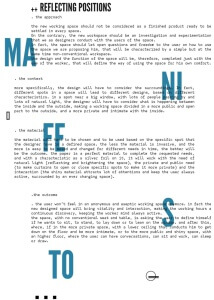THEORY with Anne Hoogewoning (Tutor Theory Course)
Numerous theorists and designers, from interior architects to anthropologists and philosophers, reflect in depth on the field covered by INSIDE. After all, interventions by designers have a profound effect on the living and working environments of people and also have major implications for the functioning of society as a whole. Future designers must possess an understanding of the most relevant theories related to their profession. Moreover, they must be capable of investigating the complexity of design commissions from various angles. Only then can substantive considerations contribute productively to the design process, and vice versa, can the design process positively influence reflection on the profession. Therefore the Theory course combines theory and research skills, providing a theoretical framework for student assignments in the studios, which all deal with specific contexts and requirements. During the two-year course the students acquire tools to link theory, critical reflection and analysis to their design process. To this end, various forms of learning are employed among others: reading and analyzing key texts that encourage discussion and debate, actively participating in discussions about the profession with fellow students and professionals, writing texts and presenting research and personal insights.
At INSIDE, the THEORY and Writing course aims for deepening understanding, strengthening basic and essential research skills, and developing an individual approach to research themes. Research here is taken to mean: systematic, critical reflection on the basis of a concrete question and definition of a topical issue or problem. The students will consult valid literature and other sources, with the aim of acquiring knowledge that offers answers to the questions posed. In general, the research encompasses the history of the profession and the discourse led by important thinkers and designers, as well as acquiring knowledge on various social and cultural contexts, which are either suggested by the tutors or chosen by the students themselves (in the second year). The aim is to stimulate students to develop a distinct attitude towards a theme, which is based on personal observations, reflections and analyses. This distinct attitude will help them take the right decisions during the design process and find their own position within this field of expertise After all, that is the moment when theory is tested in practice. In this way the theory course creates an intellectual climate in which students can prepare in the best possible way for their future roles as designers.
For examples of student work, click here.
